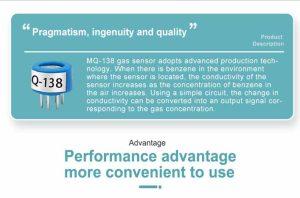The concept of a smart city is one that is driven by technology and data to improve the lives of its citizens. One of the key components of a smart city is the use of sensor networks to collect and analyze data in real-time. Gas sensor networks are an important part of this, as they can provide valuable information about air quality, pollution levels, and public health.

In this article, we will explore the potential of gas sensor networks for smart city development and how they can be harnessed to create a more sustainable and livable urban environment.
The Role of Gas Sensor Networks in Smart Cities
Gas sensor networks play a crucial role in smart city development by providing real-time data on air quality and pollution levels. This information can be used to monitor and manage environmental conditions, identify sources of pollution, and develop strategies to improve air quality.
In addition to monitoring air quality, gas sensor networks can also be used to detect and respond to gas leaks and other hazardous situations. By deploying sensors throughout a city, authorities can quickly identify and address potential safety hazards, protecting the public and preventing environmental damage.
Furthermore, gas sensor networks can be integrated with other smart city systems, such as traffic management and public transportation, to optimize urban planning and reduce the environmental impact of urban development.
Challenges and Opportunities
While the potential benefits of gas sensor networks for smart city development are clear, there are also challenges that must be addressed. One of the main challenges is the need for a large number of sensors to effectively monitor a city's air quality and pollution levels. This requires significant investment in sensor technology and infrastructure, as well as the development of data management and analysis systems.
Another challenge is the need for reliable and accurate sensor data. Gas sensors must be calibrated and maintained to ensure their accuracy, and the data they produce must be analyzed and interpreted correctly to be useful for decision-making.
Despite these challenges, there are also opportunities for innovation and collaboration in the development of gas sensor networks for smart cities. Advances in sensor technology, data analytics, and communication networks are making it easier and more cost-effective to deploy and manage large-scale sensor networks. Additionally, partnerships between government, industry, and research institutions can help to drive the development of new sensor technologies and data management systems.
Case Studies
Several cities around the world have already begun to harness the power of gas sensor networks for smart city development. For example, in London, the city has deployed a network of air quality sensors to monitor pollution levels and provide real-time data to the public. This has helped to raise awareness of air quality issues and has supported the development of policies to reduce pollution and improve public health.
In Singapore, the government has implemented a comprehensive sensor network to monitor air and water quality, as well as other environmental parameters. This has enabled the city to take proactive measures to address pollution and environmental degradation, and has supported efforts to create a more sustainable and livable urban environment.
Lessons Learned and Future Directions
The experiences of cities like London and Singapore provide valuable lessons for the development of gas sensor networks in smart cities. These cities have demonstrated that the deployment of sensor networks can have a significant impact on public health and the environment, and can support the development of policies and initiatives to improve urban sustainability.
Looking ahead, there are several key areas for future development and innovation in gas sensor networks for smart cities. These include the development of advanced sensor technologies that are more accurate, reliable, and cost-effective, as well as the integration of sensor networks with other smart city systems to create a more holistic approach to urban development.
Additionally, there is a need for continued investment in research and development to improve data management and analysis systems for sensor networks, as well as the development of policies and regulations to support the deployment and operation of sensor networks in urban environments.

Conclusion
Gas sensor networks have the potential to play a crucial role in the development of smart cities, providing valuable data on air quality, pollution levels, and public health. While there are challenges to be addressed, there are also opportunities for innovation and collaboration to drive the development of sensor networks for urban sustainability.
By harnessing the power of gas sensor networks, cities can create a more sustainable and livable urban environment, and improve the quality of life for their citizens. With continued investment and collaboration, gas sensor networks can be a key tool in the development of smart cities around the world.
 : +86 155 8830 2704
: +86 155 8830 2704 : jxdziot@gmail.com
: jxdziot@gmail.com
